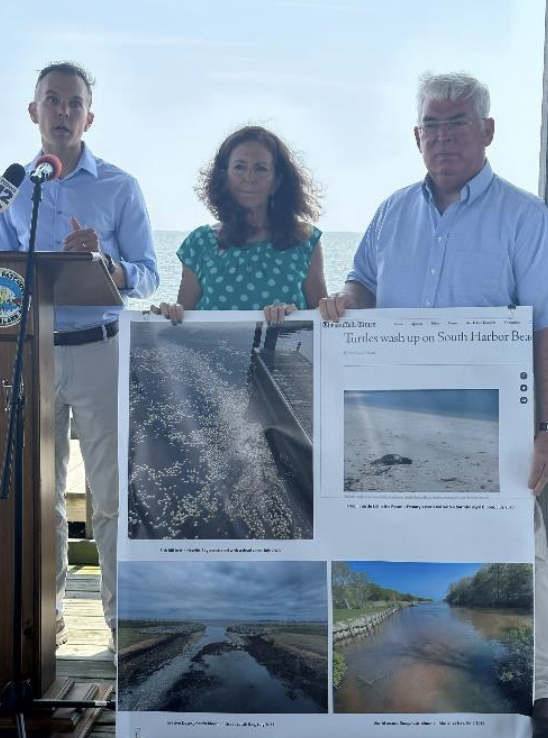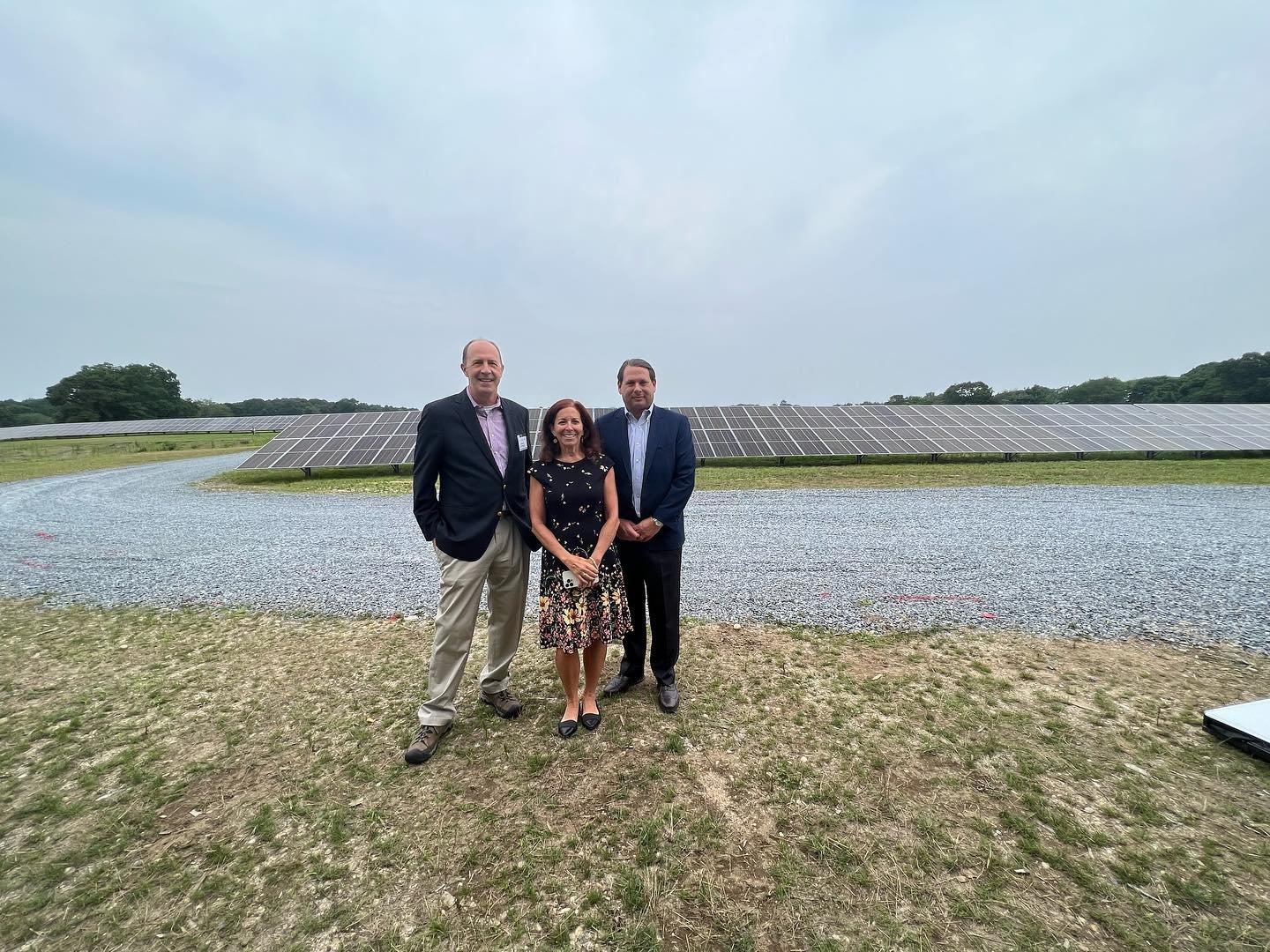World Honey Bee Day Prompts Supporters to call for Governor’s Signature on Nation-Leading Neonic Pesticide Legislation
View a recording of the press conference here.
FOR IMMEDIATE RELEASE: Tuesday, August 15, 2023
Contact: Rita Yelda, Natural Resources Defense Council, 732-979-0655, ryelda@nrdc.org
Adrienne Esposito, Citizens Campaign for the Environment, 631-384-1378, aesposito@citizenscampaign.org
Albany, NY (August 15, 2023) — With summer drawing to a close and World Honey Bee Day approaching (August 19th), legislators, advocates, and farmers from across the state called on Governor Hochul to sign the Birds and Bees Protection Act (S.1856-A Hoylman-Sigal/A.7640 Glick). They urged the Governor to demonstrate her commitment to New York’s bees and other pollinators, diverse ecosystems, agricultural future, and people by signing this bill during this year’s Climate Week in September. The bill passed both the NYS Senate and Assembly in the 2023 Legislative Session, and would be the first in the nation to address neonic seed coatings–the largest and most widespread neonic use in New York and nationwide.
Long connected to mass losses of bees and other pollinators critical to New York’s agricultural economy and environment, neonics now are emerging as likely the most ecologically destructive pesticides since DDT. In May, U.S. EPA made the unprecedented finding that neonic use is likely driving 200+ species toward extinction. The pesticides have also been linked with mass losses of birds, the collapse of aquatic ecosystems, and birth defects in deer. Widespread contaminants in New York’s water resources–and the most frequently detected insecticides in the Long Island aquifer–neonics frequently pollute New Yorker’s bodies too. Near-ubiquitous and steadily rising levels of neonics in NYS pregnant women has NYS health experts raising alarms, especially regarding children’s neurological health.
While bee losses already impact farmers economically, neonic pollution also inflicts broader harms on New York’s farms and the state’s goals for climate-smart agriculture. Neonics have made U.S. agriculture 10x to 50x more harmful to insects since their introduction, injuring species critical to soil health and carbon storage—such as beneficial nematodes, earthworms, and soil decomposers. Neonics can also more directly harm soil health by impairing beneficial bacteria crucial for plant growth and health and soil fertility and quality. Other research shows neonics travel through food webs, and can eliminate pest predators and decrease crop yields.
The Birds and Bees Protection Act would prohibit 80-90% of the neonics entering New York’s environment annually by eliminating only those uses that provide no economic benefits to users or are easily replaced by safer alternatives according to the findings of an extensive 2020 Cornell University report. It targets only neonic coatings (“treatments”) on corn, soybean, and wheat seeds and uses on lawns and gardens—without prohibiting any other agricultural uses (even other corn, soybean, or wheat uses) or treatment for invasive species. This science-based and surgical approach would address the heart of New York’s neonic pollution problem, conserving biodiversity and the state’s regenerative agricultural goals as climate stresses increase, while protecting clean water and the health of New Yorkers.
Sponsor Senator Brad Hoylman-Sigal said, “On International Honeybee Day, we recognize that we can no longer take for granted the pollinators responsible for one-third of the food we eat. Every year for the past decade, New York beekeepers have lost more than 40% of their bee colonies – largely due to neonicotinoid pesticides. New York can help reverse this trend with our Birds and the Bees Protection Act to restrict the use of this toxic class of pesticides that threatens the future of our agricultural industry. I join the Sierra Club, NRDC, NYLCV, Clean & Healthy York, Assemblymember Glick and Senator Harckam, farmers and beekeepers and strongly urge Governor Hochul to sign this nation-leading bill to help protect our environment for future generations of New Yorkers."
Assemblymember Deborah Glick, Chair of the Assembly Environmental Conservation Committee, said, “Pollinators are vital members of healthy ecosystems and our food supply chain. Protecting them by limiting toxins that pose adverse effects and health risks is an important step forward in our work to stop poisoning the environment and create a healthier New York. I urge Governor Hochul to join with the Assembly and Senate in protecting New York’s pollinators and prioritizing the environment by signing the Birds and Bees Protection Act into law.”
Senator Pete Harckham, Chair of the Senate Environmental Conservation Committee, said “It’s critical that Governor Hochul sign the Birds and Bees legislation to protect the health of humans and other living species on our planet. The use of neonicotinoid insecticides, which damage the central nervous systems of insects, including pollinators like honeybees, must be regulated and reduced or we risk further disruptions to our ecosystems and adverse human health outcomes as well.”
"As an organic farmer and a mother, I'm urging Governor Hochul to sign the Birds and the Bees Protection Act TODAY!” said Corinne Hansch, Lovin’ Mama Farm, Amsterdam, NY. “The signing of this bill will leave a beautiful environmental legacy for future generations of clean water, clean soil, and an intact biological community of pollinators that we all rely on for the production of fruits and vegetables. Signing the Birds and the Bees Protection Act ensures the health of future generations and a world with bees, butterflies, songbirds, apples, blueberries, pumpkins, and many other species necessary for life on earth."
“The Birds and Bees Protection Act points farmers toward healthier ways to grow healthier food,” said Dr. Kathy Nolan, a pediatrician and President of the New York Chapter of Physicians for Social Responsibility. “No one should be allowed to add nicotine-like substances to our food and water,” Dr. Nolan emphasized, “yet this is what farmers have inadvertently been doing when using seeds painted with neonicotinoid chemicals. I call on Governor Hochul and farmers across New York to protect pregnant women and developing children by embracing the BBPA and ending the practice of using seeds that introduce nicotine-like chemicals into our food and drinking water.”
“The Birds and the Bees Protection Act would be the first in the country to limit neonic seed coatings, and it’s essential for Governor Hochul to lead nationally by signing the bill,” said Dan Raichel, Acting Director of NRDC’s (Natural Resource Defense Council) Pollinator Initiative. “We’ve long known neonics kill bees, but we now see links between neonics and mass losses of birds, the collapse of fisheries, developmental risks in people, and vast water contamination in New York. All of the harmful neonic uses targeted by the bill are easily replaced with safer alternatives — most often nothing — which makes this a common-sense bill for New York.”
“In order to save the planet we need to save the bees. Governor Hochul has an un-BEE-lievable opportunity to be a national leader in addressing unnecessary and harmful uses of toxic neonic pesticides,” said Adrienne Esposito, Executive Director, Citizens Campaign for the Environment (CCE). “Neonics kill pollinators, poison our waters and are harming our health. This critical bill will have an immense impact in protecting our pollinators, restoring food security, protecting human health and water quality from these toxic pesticides. CCE urges Governor Hochul to sign this landmark legislation and protect our pollinators.”
“The protection of our pollinators from toxic pesticides is of utmost importance at a time when they are profoundly threatened by other environmental factors due to climate change. Neonicotinoids serve no value to the corn, soybean and wheat crops they are used on. Instead, contribute to ongoing mass population loss in birds and bees, compromise human health, and contaminate the environment,” said Bobbi Wilding, Executive Director of Clean+Healthy. “We thank Senator Brad Hoylman-Sigal and Assemblymember Deborah Glick for sponsoring the Birds and Bees Protection Act to protect us all - and we urge Governor Hochul to sign this bill into law.”
Katie Baildon, Policy Coordinator, Northeast Organic Farming Association, New York said, “Unnecessary uses of neonics are harming NY food production. Wasteful neonic use threatens pollinators that provide an estimated $389 million in pollination services, eliminates beneficial insects that farmers rely on, and harms soil health. The NOFA-NY community appreciates the NYS Legislature’s leadership in passing S.1856-A/A.7640 and urges Governor Hochul to sign the Birds and Bees Protection Act to protect our food, NY’s ecosystems and our health.”
“The science continues to show just how damaging neonics are for pollinator populations, but more and more data is emerging to highlight the toxic implications these pesticides are having on New York’s water and soil health, and the growing concern to public health,” said Caitlin Ferrante, Conservation Program Manager, Sierra Club Atlantic Chapter. “New York can be a leader in science-based neonic regulation by eliminating unjustified high-cost, low-benefit neonic uses. This reasonable approach would not prevent invasive species treatment nor agricultural uses beyond treated corn, soybean, and wheat seeds, and it would benefit pollinators, our state’s farmers who depend on them, New York’s ecosystems, and all New Yorkers who value clean soil, clean water, and their own health. We are grateful for the leadership of the NYS Legislature in passing S.1856-A/A.7640 and the leadership of the bill sponsors, Senator Hoylman-Sigal and Assemblymember Glick. We call on Governor Hochul to listen to the science and sign the Birds and Bees Protection Act into law today.”
“By eliminating unnecessary and harmful chemicals in our treatment of pests, we will help protect New York's environment, food security, and agricultural economy,” said Andrew Williams, Deputy Director of State Policy for the New York League of Conservation Voters. “It's time for New York to finally take action to ensure the survival of our essential pollinators and the health of our communities, and that is why NYLCV stands with our partners in urging Governor Hochul to sign the Birds and Bees Protection Act.”
Peter Nelson, New York beekeeper, and director of the documentary film, the Pollinators said “The passage of the Birds and Bees Protection Act is a major accomplishment and a win for all beekeepers in New York state as well as the general public. Regulating the use of neonicotinoid insecticides is a huge step towards creating a less toxic environment for managed honey bees, as well as hundreds of species of native bees, other beneficial insects and birds.”
“Yes, neonics are highly effective at killing pests, but they are equally as effective at harming birds, bees, and other pollinators essential to New York’s food security, environment, and agricultural economy,” said Dillon Klepetar, Farmer/Owner of Echo Farm in Essex, NY and Advocate from the Essex Farm Institute. “Farmers are some of the most innovative problem solvers. With several years to phase out this class of chemicals and the exemptions written in the bill, we need not trade profitability for future crop pollination.”
“Pollinators are essential to New York State’s food security, agricultural economy, and environment,” said Kevin Chlad, Director of Government Relations for the Adirondack Council. “We applaud Senator Hoylman-Sigal and Assemblymember Glick for passing the Birds and Bees Protection Act this year and urge Governor Hochul to sign this bill into law immediately, for our wildlife, for public health, and for our future.”
###


























